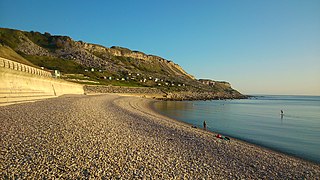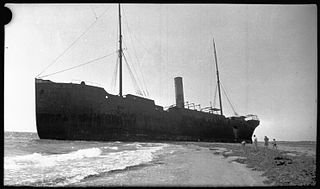
A shipwreck is the wreckage of a ship that is located either beached on land or sunken to the bottom of a body of water. Shipwrecking may be intentional or unintentional. There were approximately three million shipwrecks worldwide as of January 1999, according to Angela Croome, a science writer and author who specialized in the history of underwater archaeology.

King George Sound is a sound on the south coast of Western Australia. Named King George the Third's Sound in 1791, it was referred to as King George's Sound from 1805. The name "King George Sound" gradually came into use from about 1934, prompted by new Admiralty charts supporting the intention to eliminate the possessive 's' from geographical names.

SS Georgette was a steamship built in 1872. She is best known, especially in Irish-American circles, for the part played in the story of the Catalpa rescue in April 1876. While the events surrounding her shipwrecking eight months later are dramatic and did capture the imagination of the local press, the ship itself had little effect on the coastal trade. Though heralding the way forward in the change from sail to steam on the long Western Australian coast, like its predecessor SS Xantho, Georgette had a short and ill-starred career and sank soon after its arrival there.

Chesil Cove is a curved steep bank forming the south-east end of 29-kilometre (18 mi) Chesil Beach in Dorset, England. It is thus part of one of three large shingle structures in Britain, extending from West Bay to the Isle of Portland, the latter acting more firmly as a great barrier (groyne) which stops tidal action from washing the beach away and leads to the high depositions by wind and tide action forming the grand curved bank of this "cove". The "cove", bill and much of Chesil Beach give shelter from the prevailing winds and waves for much of Weymouth Bay, the town of Weymouth and the village of Chiswell. It forms part of the Jurassic Coast.

HMS Sappho was a Royal Navy brig that gained public notoriety for causing a diplomatic incident over the slave trade with the United States of America and then went missing off the Australian coast in 1857–58.
Over 1400 ships have been wrecked on the coast of Western Australia. This relatively large number of shipwrecks is due to a number of factors, including:

Cherry Venture was a 1600-ton cargo ship of Scandinavian origin. It ran aground on Teewah Beach in South East Queensland, Australia on 6 July 1973 and remained on the beach for 34 years until its removal in early 2007.

City of York was a 1,194-ton iron ship which sank after hitting a reef off Rottnest Island in the last few kilometres of its voyage from San Francisco to Fremantle, Western Australia in 1899.

Geffrard was a 321-ton British brig that traded between Australia, Mauritius, and Shanghai, and was wrecked off the coast of Western Australia on 13 June 1875. She was built in 1853 by Fred Clark in Jersey in the Channel Islands. By 1873 she had made her way to Melbourne and was owned by Fred Davis and under the control of Captain William James Munday. Her movements after that were generally around the southern coasts of Australia, from Geraldton in the west to Sydney in the east, laden with a variety of general cargo.

SS Kwinana was an Australian ocean-going cargo and passenger steamship. She was built in England in 1892 as the cargo ship SS Darius. In 1912 she changed owners, was refitted as a cargo and passenger ship and renamed Kwinana.
George Cheyne was an early settler in the Great Southern region of Western Australia.

John Moir was a settler and pastoralist in the areas to the east of Albany, in the Great Southern region of Western Australia.
Wave was a brig that was wrecked in 1848 at Cheynes Beach near Cape Riche, Western Australia.
The Hive Shipwreck is a heritage-listed shipwreck site of the Hive, a former convict transportation ship located approximately 40 metres (130 ft) off Bherwerre Beach, Jervis Bay Territory, Australia. It was added to the New South Wales State Heritage Register on 1 April 2010.









